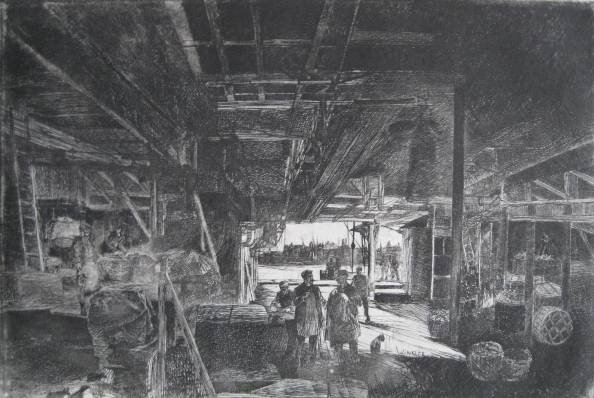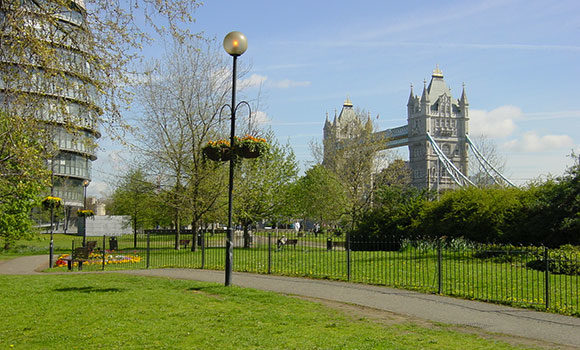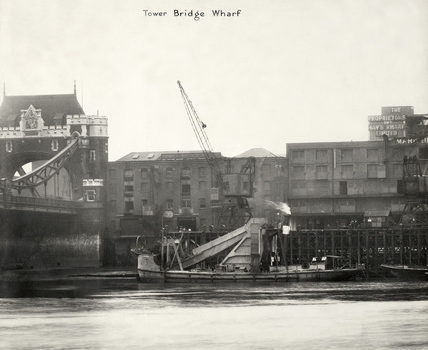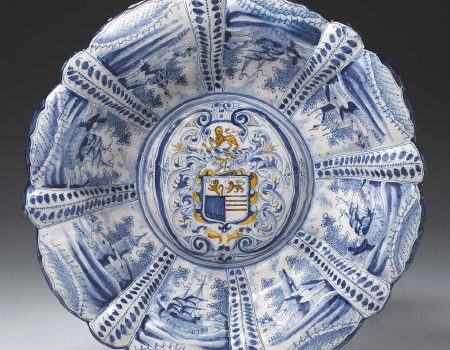History of Potters Fields Park
The Park’s rich past defines its name as ‘Potters Fields’ and makes it special. Many of the Park’s features refer to its varied history – as London’s pottery kiln, as London’s trade hub, London’s ecological and community space and London’s tourist destination.
Image: Digging up the Park in the 1970s © David Goode
London’s Pottery Kiln
A Potters Field was originally a space where poor people were buried; in biblical times, priests bought clay-rich land owned by pot-makers for their burial grounds. Over the centuries, Potters Fields Park has been used as both a burial ground and a site for pottery manufacture.
The area name ‘Potts Fielde’ dates back to its first use on a London map in 1681 when the area was the hub of the English Delftware trade. In 1618 a young Dutchman, Christian Willhelm, built and ran the Pickleherring Pottery, roughly where City Hall stands today.
At its peak, the pottery employed around 40 potters making English Delftware, which was internationally renowned. The work was so impressive that King Charles I appointed Willhelm as the Royal Galleypot Maker. The pottery’s distinctive designs featured sweeping leaves and foliage which are referenced today in the Park’s granite seating and entrance portal on Tooley Street.
The area’s proximity to the Thames was essential, as clay was bought to London in ships from other parts of the world. The Pickleherring Pottery remained in operation until 1708, when the site was relocated close to St. John’s Horselydown (site of St. John’s Churchyard) by two wealthy gentlemen, Richard Grove and James Robins. Potters Fields was then developed by traders who built warehouses specialising in the trade of cotton, ivory, tallow and sugar.

Pickle Herring Wharf
William Curtis Ecology Park, 1982 ©David Goode
London’s Trade Hub
As Queen Victoria’s empire expanded, so did the Pool of London (the stretch of the Thames between London Bridge and Rotherhithe) which became the busiest section of river in the world. Ships carried everything from exotic produce such as coffee and chocolate to everyday items such as hay bales and fish.
In 1856, Hays Wharf was built by William Cubitt for the Hays Wharf Company, the largest and most powerful of the dockside companies. Potters Fields was now home to two large granaries, built up above ground level to protect the grain from rats.
In 1861, the Great Fire of Tooley Street (which lasted for two weeks) resulted in most of the buildings in the area being destroyed or severely damaged, including the granaries. Described in reports as the worst fire since the Great Fire of London (1666) the fire wiped out 11 acres of riverside land and resulted in many warehouses being put out of action.
After Tower Bridge was officially opened in 1894, Potters Fields became known as Tower Bridge Wharf and was home to one of the largest leather trade import hubs in London; hides and skins arrived by boat from the East Indies for treatment in nearby Bermondsey. By the early 1900s, the name changed to Mark Brown’s Wharf, which eventually became a subsidiary of the Hays Wharf Group. The variety and amount of food arriving at the docks led to it being affectionately named as London’s Larder in the 1930s and it served local markets such as Smithfields and Borough Market.
In the 1940s, the area was severely damaged during The Blitz and many people living and working in the area lost their lives. Almost 25,000 bombs were dropped on London’s docks alone; the Thames docks were particularly targeted, as almost a third of Britain’s overseas trade passed through every year.
Potters Fields Park c. 2004

Potters Fields Park Management Trust was forged out of this community spirit. The Trust is a not-for-profit organisation and has been in operation managing Potters Fields Park since 2005. The Board of Directors consists of local stakeholders and every decision is carefully considered for its benefit to the community.
In 2017, the management of St. John’s Churchyard was also entrusted to Potters Fields Park Management Trust by Southwark Council.
© PLA Collection, Museum of London

London’s Ecological Community Space
By the end of the 1950s, many of the docks were abandoned. Large shipping containers needed bigger vessels and deeper water, which London’s central docks were unable to accommodate. Sea trade moved downriver to Tilbury and Felixstowe, where cranes were used instead of dockers to lift containers off ships. By 1970, all the docks had closed, leaving wharves and bankside space ripe for redevelopment. HMS Belfast arrived in 1971 and opened to
the public; it is now visited by thousands of people every year.
To commemorate Queen Elizabeth II’s Silver Jubilee in 1977, The Trust for Urban Ecology (TRUE) leased the land for a short tenure, during which Britain’s first urban ecology park was created. Known as The William Curtis Ecology Park (after Bermondsey-based 18th Century botanist William Curtis) the TRUE transformed the site from a derelict lorry park into a thriving wildlife sanctuary and education centre. Young Londoners were encouraged to be hands-on with nature, and enjoyed activities such as pond dipping, bird watching and insect drawing.
The peaceful respite and educational offering of the William Curtis Ecological Park was much loved by local people, but by 1982, TRUE had to hand the land back. A new Development Master Plan had been drawn up and after a long community campaign and public inquiry, the plans were amended to include a new riverside walkway and a 3-acre park.
At the Park’s official re-opening as ‘London Bridge City Park’ in 1988, a crowd of people, unhappy with the Park’s name, gathered to prevent the ceremony, which was postponed. The community organised its own re-opening ceremony, having agreed to call it ‘Potters Fields Park’.
The new park marked a successful end to a long battle led by local resident, Lil Patrick, who started the campaign in the late 1970s. Lil opened the new park with the words ‘Every blade of grass is worth its weight in gold’ – a phrase inscribed within the Park and which still guides us today. Without the dedication of local people, the park in its current form may have never existed.
Potters Fields Delftware plate, c.1650

London’s Tourism Hub
In 2002, City Hall opened on land to the west of the Park. With our proximity to HMS Belfast and Tower Bridge, we are surrounded by three major tourist destinations and are at the heart of the vibrant London Bridge district. As the City of London across the river continues to develop and build taller skyscrapers, the Park also boasts unrivalled views of the City’s gleaming architectural giants such as ‘The Walkie Talkie’ and ‘The Gherkin’.
Designated in 2005 as Metropolitan Open Land and extensively landscaped in 2007, the Park has been transformed into a beautiful, world class facility, which thousands of people enjoy every day. The re-design created a place for both public events and private contemplation; a park which reflects its distinctive local history and provides a safe, clean and restful space within the bustle of the city.

